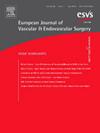经皮与手术制造的前臂近端动静脉瘘的长期对比研究。
IF 5.7
1区 医学
Q1 PERIPHERAL VASCULAR DISEASE
European Journal of Vascular and Endovascular Surgery
Pub Date : 2025-05-01
DOI:10.1016/j.ejvs.2025.01.020
引用次数: 0
摘要
目的:这项回顾性、单中心、比较疗效的研究旨在比较前臂近端经皮动静脉瘘(pAVF)和手术形成的动静脉瘘(sAVF)用于血液透析通路的长期结果。方法:从2017年9月至2023年9月期间接受pAVF或sAVF创建的患者的前瞻性维护数据库中回顾数据。共分析了217个pavf(61个wavinq和156个Ellipsys)和158个savf。结果测量包括技术成功、成熟、通畅、首次成功使用时间、再次干预和并发症。结果:sAVF和Ellipsys的技术成功率为100%,wavinq的技术成功率为93.4% (p < 0.001)。Ellipsys组(78.6%)和sAVF组(79.7%)的4周成熟度高于wavinq组(64.9%)(p = 0.042)。到首次插管的中位时间最短的是Ellipsys(57天),其次是sAVF(73天),最长的是wavinq(98.6天)(p = 0.048)。平均随访654天(四分位数差164,1 049天;范围0 - 2061天)。原发性通畅在sAVF中高于在pavf中。与sAVF相比,wavinq组原发性通畅丧失的Cox比例风险比(HR)为1.50,Ellipsys组为1.42 (p = 0.045)。wavinq组的继发通畅有统计学意义(HR 2.76;p < .001),但椭圆型没有(HR 0.74;P = .33)。血液透析通路诱导的远端缺血(HAIDI)在sAVF组中更为常见,有9例(5.7%),而Ellipsys组为1例(0.64%);P = .008)。每名患者每年的再干预率在各组间具有可比性(sAVF、wavinq和Ellipsys分别为0.60、0.61和0.69)。结论:本研究表明,虽然所有通路类型都可以提供长期的功能性血液透析通路,但sAVF在某些结果域中表现更好,而pavf(特别是椭圆)在其他结果域中表现更好,sAVF显示出更高的HAIDI率,但更低的吻合口旁狭窄率。研究结果强调了个性化血管通路规划的重要性,权衡了即时的手术结果和长期的功能。本文章由计算机程序翻译,如有差异,请以英文原文为准。
Long Term Results of a Comparative Study of Percutaneous and Surgically Created Proximal Forearm Arteriovenous Fistulae
Objective
This retrospective, single centre, comparative effectiveness study aimed to compare the long term outcomes of percutaneous arteriovenous fistula (pAVF) and surgically created arteriovenous fistula (sAVF) created in the proximal forearm for haemodialysis access.
Methods
Data were reviewed from a prospectively maintained database on patients who underwent pAVF or sAVF creation from September 2017 to September 2023. A total of 217 pAVFs (61 WavelinQ and 156 Ellipsys) and 158 sAVFs were analysed. Outcome measures included technical success, maturation, patency, time to first successful use, re-interventions, and complications.
Results
Technical success was 100% for sAVF and Ellipsys, and 93.4% for WavelinQ (p < .001). Maturation at four weeks was higher in Ellipsys (78.6%) and sAVF (79.7%) groups than in WavelinQ (64.9%) (p = .042). Median time to first cannulation was shortest for Ellipsys (57 days), followed by sAVF (73 days), and longest for WavelinQ (98.6 days) (p = .048). Mean follow up was 654 days (interquartile range 164, 1049 days; range 0 – 2061 days). Primary patency was higher in sAVFs than in pAVFs. The Cox proportional hazard ratio (HR) for loss of primary patency was 1.50 for WavelinQ and 1.42 for Ellipsys compared with sAVF (p = .045). Secondary patency was statistically significantly lower for WavelinQ (HR 2.76; p < .001), but not for Ellipsys (HR 0.74; p = .33). Haemodialysis access induced distal ischaemia (HAIDI) was more common in the sAVF group with nine events (5.7%) compared with one for the Ellipsys (0.6%; p = .008). Re-intervention rates per patient year were comparable across groups (0.60 vs. 0.61 vs. 0.69 for sAVF, WavelinQ, and Ellipsys, respectively).
Conclusion
This study indicates that while all access types can provide long term functional haemodialysis access, sAVFs perform better in some outcome domains and pAVFs (particularly Ellipsys) in others, with sAVFs showing higher rates of HAIDI, yet lower rates of juxta-anastomotic stenosis. The findings underscore the importance of personalised vascular access planning, weighing immediate procedural outcomes against long term functionality.
求助全文
通过发布文献求助,成功后即可免费获取论文全文。
去求助
来源期刊
CiteScore
6.80
自引率
15.80%
发文量
471
审稿时长
66 days
期刊介绍:
The European Journal of Vascular and Endovascular Surgery is aimed primarily at vascular surgeons dealing with patients with arterial, venous and lymphatic diseases. Contributions are included on the diagnosis, investigation and management of these vascular disorders. Papers that consider the technical aspects of vascular surgery are encouraged, and the journal includes invited state-of-the-art articles.
Reflecting the increasing importance of endovascular techniques in the management of vascular diseases and the value of closer collaboration between the vascular surgeon and the vascular radiologist, the journal has now extended its scope to encompass the growing number of contributions from this exciting field. Articles describing endovascular method and their critical evaluation are included, as well as reports on the emerging technology associated with this field.

 求助内容:
求助内容: 应助结果提醒方式:
应助结果提醒方式:


